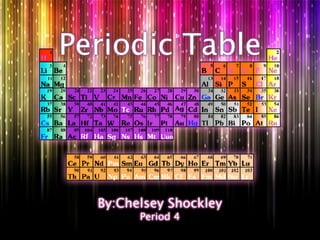
Periodic table of elements
- 1. Periodic Table By:Chelsey Shockley Period 4
- 2. Where, Who, and How? Was discovered in Russia Dmitri Mendeleev was the man who created it. Mendeleev created the table by gathering and organizing elements
- 3. How is the table The table is organized by atomic number, metals, nonmetals, metalloids, periods, groups, and stability The columns that go across are periods The columns that go down are groups.
- 4. Relationships between elements In each group or family the elements have the same number of valence electrons.
- 5. Element 1 Helium Atomic Number-2 Element Symbol-He Atomic Mass-4.002602 It is used in balloons Helium is the second lightest element and is the second most abundant element in the observable universe. Its abundance is similar to this figure in the Sun and in Jupiter. Helium is named for the Greek God of the Sun, Helios
- 6. Element 2 Gold Atomic Number-79 Element Symbol-Au Atomic Mass-196.96 It is used on jewelry Gold resists attacks by individual acids, but it can be dissolved by the aqua regia, A total of 165,000 tones of gold have been mined in human history, as of 2009. It has been claimed that most of the Earth's gold lies at its core, the metal's high density having made it sink there in the planet's youth.
- 7. Element 3 Atomic Number-26 Element Symbol-Fe Atomic Mass-55.84 You have to have iron in your blood to live and it is uses in building It is the most common element (by mass) forming the planet Earth as a whole, forming much of Earth's outer and inner core, Pure iron is soft (softer than aluminium), but is unobtainable by smelting., Iron is of greatest importance when mixed with certain other metals and with carbon to form steel.
- 8. Sites • http://www.aip.org/history/curie/ periodic.htm • http://www.ptable.com/ • http://www.numbersleuth.org/ worlds-gold/
Notas del editor
- \n
- \n
- \n
- \n
- \n
- \n
- \n
- \n